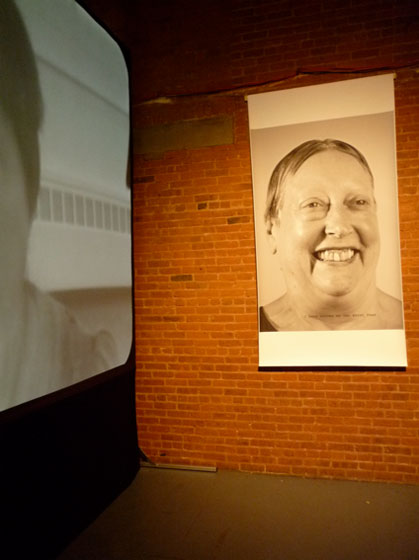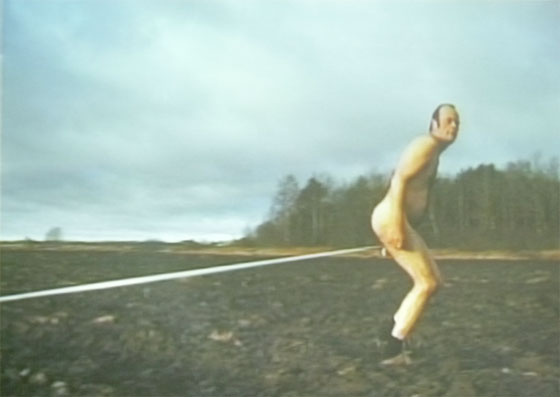
Jesse Flemming's The Snail and The Razor at The Moving Image Art Fair
The Moving Image Art Fair offers a pleasant close to a hectic week of art fair viewing. Decked out with high-definition monitors, a spacious interior in Chelsea's Waterfront Tunnel, and plenty of stools and chairs, it's the perfect place to spend some time sitting down while enjoying some art. Video art is often best viewed from a bench.
It also happens to the be the only fair I’ve attended where, immediately upon entering, I was greeted by a dealer ranting about capitalism. Yesterday’s panel discussion, “What Do You Get When You Buy Video Art”, prompted the outrage, and I'm now disappointed I missed it. It included panelists Lisa Dorin (of AIC), Jefferson Godard (the video collector), Berta Sichel (a Curator for the Reina Sofia), Fabienne Stephan (of Salon 94) and Rebecca Cleman (of EAI); I was told with great gusto that they failed to adequately address the willful rarification of video at the expense of the medium's participation in culture. “EAI is the worst offender!” the gallerist cried, lamenting their enormous “discounted” rental fees for institutions.
This kind of conversation, in and of itself, distinguishes Moving Image from the host of other fairs in town this week; the fair prides itself on keeping the sales out of sight—there are no dealers on hand to sell work on the spot—and the exhibition hall is a refreshingly idealistic space, designed to bring attention to the art more than finalize sales.
The videos themselves are a draw, too. Anyone who’s watched online the short clip of Jesse Flemming’s cliffhanger chronicling a snail's travels over a razor will have an opportunity to see the video in full at Moving Image. “People have been coming in just to see what happens,” fair co-founder Murat Orozobekov told us, noting the video had sold out. Company, a participating gallery based in LA, handles the piece, aptly titled “The Snail and The Razor”.

Martha Wilson, "I've Become My Own Worst Fear", 2009
With five fewer TV screens than last year, the space feels a little more open than it did in 2011, though a good selection of video remains. Mary Lucier, VALIE EXPORT, Martha Wilson, three well-known female artists from the 70s, are some of the bigger names showcased this year at the fair, along with emerging artists such as Kate Gilmore and Alex Prager.
Of the installation work, Josh Azzarella's three-channel projection “Untitled #105 (SFDF)” (2009-11) from DCKT Contemporary makes a splash. Each panel shows a single, subtly animated still from the original King Kong (1933); for most Kong fans, Merian C. Cooper's sets will be immediately recognizable. A quiet assortment of naturey-jungle sounds lends to the installation's eerie presence.

Jaan Toomik, "Untitled" 2002
Head to the back of the tunnel, and a giant projection screen documents Estonian performance artist Jaan Toomik's collaborator Alar Sudak. His penis tied to a stake in the ground, he forces himself to mark out a circle as far as he can reach away from the stake, putting himself in obvious pain. It strikes a somewhat different note from the King Kong work. It's an anxiety-inducing piece, but in a lot of ways isn't nearly as powerful as Wilson's installation “I've Become My Own Worst Fear”. In this work, the artist juxtaposes an early 1974 video piece, in which she uses make up to age her face, with a wall-sized portrait of herself in 2009. She has aged, arguably, even worse than she imagined.
I took shots of both this installation and Toomik's, though it was a little more difficult to find the right angle of Sudak. “You’re waiting to get a shot of his penis, right?” an attendee asked me. I laughed, thinking it was nice that he could immediately identify what I was doing and why. The relaxed atmosphere of the hallway made this sort of interaction—a rarity at the other fairs—common, and as I tried again to photograph the dick on my iPhone, I noticed that it felt a lot like community.


{ 12 comments }
Nice review. For the record, it was not me bitching about EAI restrictive ways in their effort of “protecting the art and artists” but I have to agree. Making access difficult to the medium’s history underprivileges it. An amazing case in point is the Warsaw MOMA, a Polish museum putting its Filmoteka online. An amazing treasure trove of 400 video artworks of past forty years. For serious research and for when you are bored on a rainy day http://www.artmuseum.pl/filmoteka/ This just seems so much more reasonable and current model.
Great write up! I really enjoyed the Moving Image Fair this year and can completely empathize with you on all points/ works mentioned. I was really impressed by Toomik’s videos in particular. Also, AWESOME TITLE for this post.
Thank you so much for the thoughtful response to Moving Image, Paddy. It’s refreshing to read a review by someone who, you know, actually took the time to watch and respond to the videos.
And I have to agree with Don…truly awesome title. : – )
We do indeed pride ourselves on keeping the atmosphere at Moving Image free of the pressures to engage with the dealers (when you’d rather watch the work), but we’re also very happy to report that sales were still much, much stronger this year than last (with some galleries selling out editions and others selling many works that were not even on exhibition).
Moving Image remains in its experimental phase. We continue to welcome feedback on how to make it better (from both visitors and participating galleries), hoping to perfect the presentation whereby viewers feel comfortable taking their time and viewing the work, and the galleries still make sells.
Again, thanks for visiting the fair and the generous response.
 I can’t take credit for the title on this one: Will came up with it.
 If EAI had not preserved artists’ tapes, stored them properly, cataloged them and then later digitized them, there would be no history of video art. Those works would be lost noe. No one else was preserving video art when EAI started doing it in the 1980s. They raised the money and then got down and to a very difficult job…museums, galleries, collectors, and non-profit spaces were simply not doing it.
Of course. They did a tremendous job. And now these archives should be online
Yes their contribution is priceless, only a classic nonprofit could have done it in such comprehensive way. I would on the other hand argue that in the process they embraced the most regressive form of copyright interpretation, that is totally antithetic to contemporary flow and exchange of ‘cultural production’.( it seems like they are guided by a bad business model and/or advised by a ambitious copyright lawyer representing the interest of whom?)Â
I believe restricting basic access to these works disadvantages, first of all, the artists, it is the exposure of the subsequent generations of artists, etc. that keeps their work alive and relevant.Â
For the artists it is a dilemma, being admitted into an important international institutional collection is a great prestige, for a steep price.
isn’t it ironic that they restrict access to video recordings of performances that were broadcasted on free, public television channels?Â
Actually i do not understand how do all public donors allow using their contributions for the continuation of these outdated restrictive practices.
Yes it is a great institution in need of a MAJOR upgrade.
One useful model to look at would be Rhizome.org.
Actually EAI’s distribution model – which seems based on a film co-op onel – is way less restrictive than most museums and galleries. The idea is to provide a revenue stream to artists and the organization so they can give access in the ways they do. If artists want to put their work on line, they can, and they do. All their artists want to choose how their work is presented and its level of availability and they trust EAI to manage that.
Merci pour le partage de l’auteur. .
Panels about collecting media art are not new (online you can find aÂ
transcript for “Buying Time,†from 1999), but the tone of them hasÂ
changed – they have become less combative. I thought the discussion onÂ
Saturday was an excellent step forward to bringing more transparency toÂ
the art world’s handling of media art. I thought it was clear that allÂ
of the panelists were very concerned about keeping the work accessibleÂ
to the public. The goal was not to answer questions, but to engage thisÂ
subject from a diverse perspective, and attempt to lay out some of theÂ
major concerns around a model that is still very much in development. ItÂ
is good to add these “outrages†to the mix, though they return to theÂ
more combative discussions that in their generalization hamper theÂ
productivity of this discussion.
I’d like to speak to EAI’s portrayal here, and admit I’m confused by theÂ
two seemingly conflicting complaints: on the one hand, EAI is to blameÂ
for being overly restrictive and protective; on the other, EAI is toÂ
blame for ruining the market for media art by quoting low fees toÂ
institutions and keeping the work in distribution. The reconciliation ofÂ
these outrages would make a great topic for the second installment ofÂ
this discussion.
That’s not to dismiss either point – they are important, and EAI veryÂ
much has these issues in mind. From our founding in 1971 – access is theÂ
cornerstone of EAI’s mission (I recommend reading Howard Wise’s letterÂ
announcing the closure of his gallery, and mission statement for EAI, onÂ
our site – infused with McLuhan-esque utopianism, but prescient in manyÂ
ways.)
There are certainly impediments to providing access – and one of them isÂ
the obsolescence of technology. As John commented here, EAI has a longÂ
and important history leading and advocating for the preservation ofÂ
video formats – at a time when very few institutions or dealers wereÂ
willing to assume this responsibility (things have changed significantlyÂ
only in the last decade or so). It is absolutely true that without theseÂ
efforts, works by Joan Jonas, Dara Birnbaum, and Tony Oursler, amongÂ
many others, would simply not exist.
The imposed scarcity model of editioning also, of course, impedes accessÂ
– but it doesn’t have to. Artists have been challenging the restrictiveÂ
edition model by having editioned works posted on YouTube, circulatingÂ
through distributors such as EAI, VDB, or LUX, and available for saleÂ
through a gallery. To me this perhaps outlines an “ideal scenarioâ€â€“ theÂ
works are available in a very general and open field, extending beyondÂ
the confines of the art world and high culture, while being appreciatedÂ
by collecting institutions for their cultural value and impact. One ofÂ
the many points raised during the panel, however, is how this impacts onÂ
the notion of “ownership†– which is especially important to publicÂ
institutions acquiring the works and anticipating archiving and housingÂ
them as long as the Earth revolves…
Whether this model can work or not remains to be seen; the music andÂ
film/television industries are having their own troubles adapting, withÂ
infinitely more resources. What is often left out of the discussion ofÂ
access are the real costs related to producing and preserving media art.Â
In a context where there is very limited funding to support theÂ
preservation of analog video formats (the majority of EAI’s collectionÂ
and history) – and when moving image artists are finding it difficult toÂ
sustain their work and livelihood in a market that privileges painting,Â
drawing, and sculpture – could gallerists, distributors, andÂ
institutions find a way to support artists in their efforts, whileÂ
upholding their responsibility to keep these works available to the public?
To make clear how committed EAI is to this discussion, and to our roleÂ
as a major resource for artists, scholars, curators, collectors, andÂ
museum professionals – I’d like to point out that in 2008, we hosted aÂ
free public symposium exhibiting and collecting media art: HYPERLINKÂ
“http://www.eai.org/pressreleases/11_08_panels_pr.html”Â
Hi Rebecca,
I just wanted to start off by saying that I’m a big fan of EAI and Howard Wise – one of the chapters of my MA thesis focused on Wise’s exhibition “TV as a Creative Medium.” In order to clarify the disagreements about EAI, it’s important to discuss the difference between EAI as a historical entity in the 1970s – which served to fund artists, organize programs that wouldn’t have happened otherwise – and EAI’s position now.Â
In the 1970s, EAI’s niche video rental program was important to video artists. Prior to EAI, Howard Wise ran commercial galleries, but he became fed up with the inability for video, kinetic, and media artists to make a living. EAI helped circulate videos and assisted artists with making some financial gains off their work at a time when there was absolutely no market for video art.
Now, there is a market for video art. The questions raised by some attendees at Moving Image are about the role of EAI now: should EAI still charge rental and screening fees, and should this situation even exist now that the commercial situation has changed? I’m one of those who believes that in light of the changing economic situation – as well as the fact that we’re reaching a point of sharing art online for free – EAI should reevaluate its role as an art rental program.
As an aside, I’ve been thinking about whether the EAI model would work for net art. Would net artists be aghast at trying to sell screening or rental rights of their work? Probably not, which, isn’t a good sign for the future of this distribution model.Â
Thanks,Corinna
Thank you for your reply, Corinna – you do put forth a fundamental question about the distribution model in general. Â To the depiction of these changed times, and any adaptation to them, I’d add other impinging factors: the future of film distributors and co-ops and repertory cinema, a less open Internet culture (thanks to powerful media conglomerates), museums with greatly diminished budgets, the rise of “museum-like” private foundations competing with public museums, and the merger of art and “film” – moving-image – production models after the collapse of the “indy” studio branches. Â This is certainly a dyamic and complex moment.
I don’t think the current market for moving image work has gotten to a stable enough place to say there is a good one, per se. Â There is a market for certain kinds of work (especially installation based) – but many artists would counter that they continue to work completely outside the market, and not all of them do so electively. Â And if they do choose to work outside the market – who will preserve and archive and promote their work? Â It isn’t enough to say that it can be shared on-line. Â File-format storage is incredibly fragile, and not all artists are aware of how dependent their work is on proprietary software. Â
Personally, I am very interested in and supportive of the Creative Commons license model. Â It is an elective license, that offers artists choices about the degree to which they would like to protect or share their art. Â If any of EAI’s artists want to make their work available for free, or offer it to an institution for exhibition for free, they certainly can – and do. Â It’s their choice.Â
I feel strongly, however, that artists should be compensated for public presentations and uses of their work.  From stories and experiences I’ve had, the flagrant exploitation of artists working in time-based media (moving image or performance) is still very much a problem.  For the time being, I think that a distribution model – wether it be EAIs, VDBs, or LUX’s – offers an alternative way of making work public that does not depend on a grossly imbalanced market.
One area where I do think major changes need to be made, however, which is a current focus of ours, is in the educational realm. Â
Thanks for your thoughts,
Rebecca
Comments on this entry are closed.